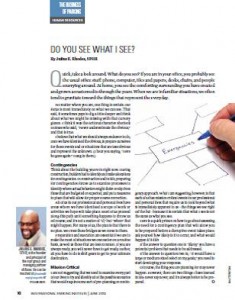Quick, take a look around. What do you see? If you are in your office, you probably see the usual office stuff: phone, computer, files and papers, desks, chairs, and people scurrying around. At home, you see the comforting surrounding you have created and grown accustomed to through the years. When we are in familiar situations, we often tend to gravitate toward the things that represent the everyday.
No matter where you are, one thing is certain: our focus is most immediately on what we can see. That said, it sometimes pays to dig a little deeper and think about what we might be missing with that cursory glance. I think it was the fictional character Sherlock Holmes who said, “Never underestimate the obvious,” and that is true.
I believe that what we should always endeavor to do, once we have identified the obvious, is prepare ourselves for those events and or situations that are less obvious and represent the unknown. (I hear you saying, “Here he goes again.” Hang in there.)
Contingencies
Think about the building you’re in right now. During construction, builders had to identify and make allocations for contingencies. In construction and in life, preparing for contingencies forces us to examine processes to identify where actual behaviors might differ or slip from those that are budgeted or expected, and put a measures in place that will allow for proper course correction.
All of us in our professional and personal lives have areas where we have identified a scope of work or activities we hope will take place. Most of us proceed along this path until something happens to throw us off course, and it’s not a matter of “if,” but “when” that might happen. For many of us, the plan is that there is no plan. We cross those bridges as we come to them.
Preparation and execution are essential if we are to make the most of situations we encounter on a routine basis, as well as those that are less common. If you are always ready, you will never have to get ready. Rather, all you have to do is shift gears to get to your ultimate destination.
Mission Critical
I am not suggesting that we need to examine every part of our lives to try and identify all of the possible scenarios that would require some sort of pre-planning or contingency approach. What I am suggesting, however, is that each of us has mission-critical events in our professional and personal lives that require us to look beyond what is immediately apparent to us—the things we see right off the bat—because it is certain that what I see is not the same as what you see.
Here is a quick primer on how to go about assessing the need for a contingency plan that will allow you to be prepared before a disruptive event takes place: ask yourself how likely is it to occur, and what would happen if it did?
If the answer to question one is “likely,” you have a potential problem that needs to be addressed.
If the answer to question two is, “It would have a large or medium-sized effect on my goals,” you need to start developing your response.
Of course, the thing you are planning for may never happen. However, there are two things I have learned in life: never say never, and it’s always better to be prepared.
Julius E. Rhodes, SPHR, is the founder and principal of the mpr group and managing partner of Axeo. He can be reached at jrhodes@mprgroup.info or 773.548.8037.
TPP-2013-06-Do You See What I See

